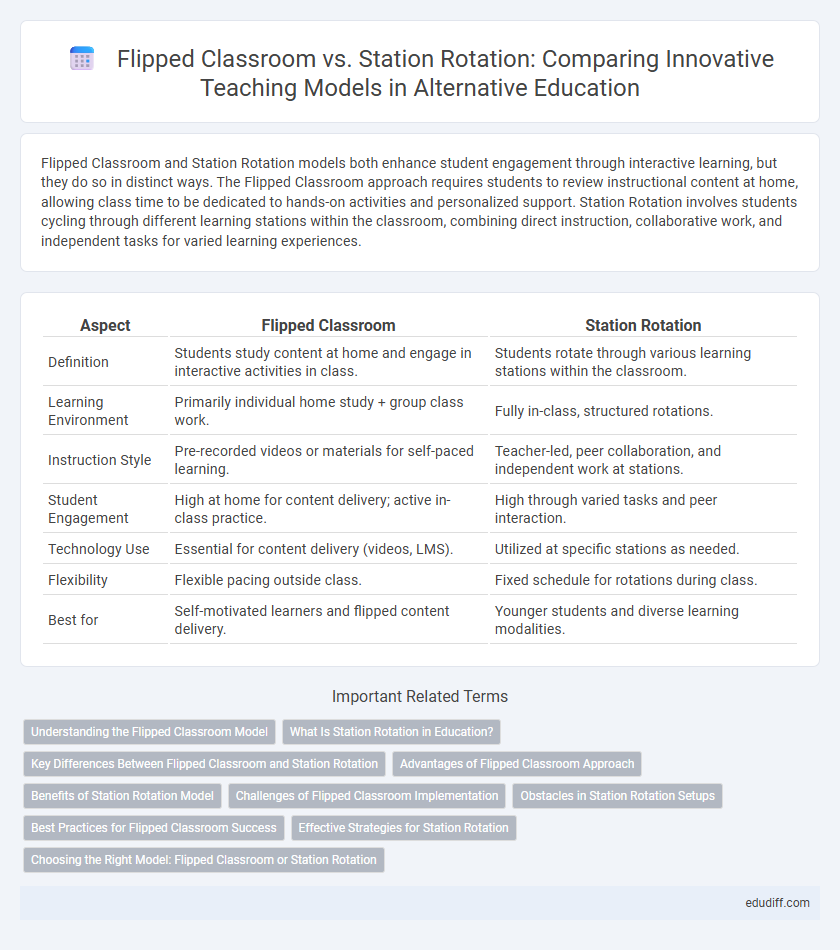Flipped Classroom and Station Rotation models both enhance student engagement through interactive learning, but they do so in distinct ways. The Flipped Classroom approach requires students to review instructional content at home, allowing class time to be dedicated to hands-on activities and personalized support. Station Rotation involves students cycling through different learning stations within the classroom, combining direct instruction, collaborative work, and independent tasks for varied learning experiences.
Table of Comparison
| Aspect | Flipped Classroom | Station Rotation |
|---|---|---|
| Definition | Students study content at home and engage in interactive activities in class. | Students rotate through various learning stations within the classroom. |
| Learning Environment | Primarily individual home study + group class work. | Fully in-class, structured rotations. |
| Instruction Style | Pre-recorded videos or materials for self-paced learning. | Teacher-led, peer collaboration, and independent work at stations. |
| Student Engagement | High at home for content delivery; active in-class practice. | High through varied tasks and peer interaction. |
| Technology Use | Essential for content delivery (videos, LMS). | Utilized at specific stations as needed. |
| Flexibility | Flexible pacing outside class. | Fixed schedule for rotations during class. |
| Best for | Self-motivated learners and flipped content delivery. | Younger students and diverse learning modalities. |
Understanding the Flipped Classroom Model
The Flipped Classroom model in alternative education shifts traditional lectures outside of class through video lessons, allowing in-person time to focus on interactive activities and personalized support. This approach enhances student engagement by promoting active learning and deeper comprehension during class sessions. Compared to the Station Rotation model, which divides class time into different learning modalities at rotating stations, the Flipped Classroom centralizes content delivery before class, optimizing face-to-face interaction for collaborative problem-solving and critical thinking.
What Is Station Rotation in Education?
Station Rotation in education is a blended learning model where students rotate through various learning stations, including online learning, group work, and teacher-led instruction, within a single classroom. This approach allows personalized learning by catering to different learning styles and pacing while maximizing classroom engagement. Station Rotation contrasts with the Flipped Classroom by integrating diverse activities in real-time rather than assigning content consumption as homework.
Key Differences Between Flipped Classroom and Station Rotation
Flipped Classroom shifts direct instruction outside the classroom through video lectures, allowing in-class time for active learning and personalized support, whereas Station Rotation divides students into small groups rotating through learning modalities such as collaborative activities, technology-based exercises, and teacher-led instruction within the classroom. The key difference lies in the location and timing of content delivery: Flipped Classroom requires pre-class preparation, while Station Rotation manages diverse learning tasks during class sessions. This distinction impacts student engagement, pacing, and the teacher's role in facilitating differentiated instruction.
Advantages of Flipped Classroom Approach
The flipped classroom approach enhances student engagement by delivering instructional content online outside of class, allowing in-class time for active learning and personalized support. It promotes deeper understanding and higher retention through interactive activities that cater to diverse learning styles. This method also empowers students to learn at their own pace, improving self-regulation and fostering critical thinking skills.
Benefits of Station Rotation Model
The Station Rotation model enhances personalized learning by allowing students to engage with content at their own pace across multiple stations, catering to diverse learning styles and needs. It promotes active collaboration and peer interaction, fostering deeper understanding through varied activities such as group work, technology-driven tasks, and teacher-led instruction. This flexible structure maximizes classroom engagement and efficiency, enabling teachers to provide targeted support and formative assessment more effectively than traditional or flipped classroom models.
Challenges of Flipped Classroom Implementation
Flipped Classroom implementation faces challenges including student resistance to self-directed learning and uneven access to technology at home, which can hinder equitable participation. Teachers often struggle with creating engaging pre-class materials and managing in-class activities that effectively reinforce concepts. Time constraints and lack of professional development further complicate effective adoption compared to Station Rotation, where in-person guidance is more consistent.
Obstacles in Station Rotation Setups
Station rotation setups often face logistical challenges such as limited classroom space and inadequate technology infrastructure, which hinder smooth transitions between stations. Teachers may struggle with time management and monitoring multiple groups simultaneously, impacting the effectiveness of personalized learning. Student engagement can decline if rotations feel rushed or confusing, reducing the overall benefits of the approach.
Best Practices for Flipped Classroom Success
Flipped Classroom success hinges on clear instructional videos, active student engagement, and timely formative assessments that reinforce learning concepts outside traditional class time. Teachers should design pre-class materials aligned with in-class activities to maximize deep understanding and foster collaborative problem-solving. Integrating technology platforms that track student progress and encourage interactive discussions significantly enhances the effectiveness of the flipped model.
Effective Strategies for Station Rotation
Station rotation enhances learning by cycling students through diverse, targeted activities that cater to varied learning styles, increasing engagement and retention. Incorporating technology-enabled tasks alongside teacher-led sessions maximizes instructional time and allows personalized support. Effective strategies include designing clear rotation schedules, integrating formative assessments at each station, and fostering collaboration to deepen understanding and skill mastery.
Choosing the Right Model: Flipped Classroom or Station Rotation
Choosing the right model depends on the specific learning objectives and student needs; the Flipped Classroom excels in promoting independent pre-class preparation and deep in-class discussions, while Station Rotation offers structured, diverse activities that cater to different learning styles within one session. Flipped Classroom integrates technology for students to access lectures anytime, fostering self-paced learning, whereas Station Rotation facilitates hands-on interaction with teachers and peers through rotating small group activities. Evaluating factors such as classroom resources, student autonomy, and content complexity helps educators determine whether Flipped Classroom's flexibility or Station Rotation's interactive cycles better enhance engagement and mastery.
Flipped Classroom vs Station Rotation Infographic

 edudiff.com
edudiff.com